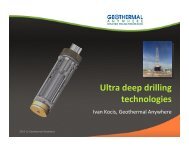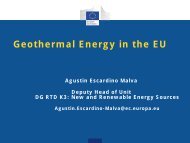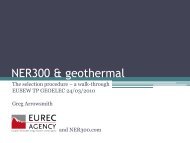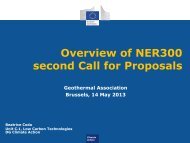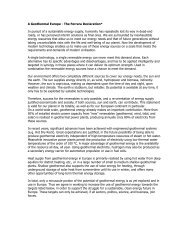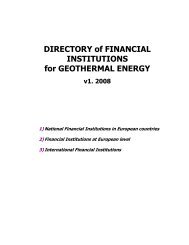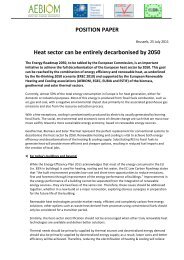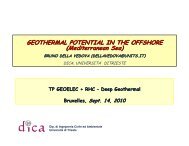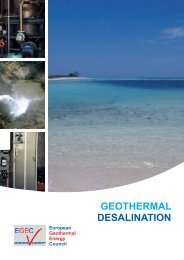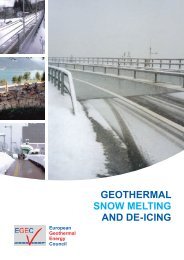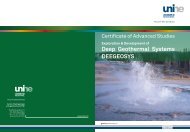Strategic Research and Innovation Agenda for Renewable ... - EGEC
Strategic Research and Innovation Agenda for Renewable ... - EGEC
Strategic Research and Innovation Agenda for Renewable ... - EGEC
You also want an ePaper? Increase the reach of your titles
YUMPU automatically turns print PDFs into web optimized ePapers that Google loves.
<strong>Renewable</strong>Heating & CoolingEuropean Technology Plat<strong>for</strong>m4.3.1 <strong>Research</strong> <strong>and</strong> innovation priorities with impact in the Short TermAs biomass technologies covering the heat <strong>and</strong> sanitary water dem<strong>and</strong> of the servicesector become increasingly competitive, more demonstration projects are needed tocreate confidence <strong>and</strong> to spur Europe-wide diffusion. The main challenges are in the development<strong>and</strong> demonstration of cost-efficient <strong>and</strong> energy-efficient system concepts, whichmake use of different technologies <strong>for</strong> RHC in bi- or multivalent (hybrid) systems. Intelligentsystem design <strong>and</strong> effective heat storage are key priorities <strong>for</strong> efficiencyimprovements. Another core element is the development of integrated, plug & play controltechnology optimised <strong>for</strong> the integrated use of other renewable energy technologies <strong>and</strong>relevant components.Whilst the above is mostly related to cross-cutting topics, the main challenges related onlyto biomass technology are the development of cost-effective solutions to reducedust emissions <strong>and</strong> the development of small scale CHPs.BIO.6ObjectiveCost effective solutions to reduce dust emissionsIn order to overcome the tightening of air quality requirements, secondary measuresto reduce dust emissions will be required in the future. There<strong>for</strong>e, reliable <strong>and</strong> cost-effectivePM abatement technologies <strong>for</strong> applications of roughly 100 to 500 kW th are to be developed<strong>and</strong> demonstrated. These can either be fabric filters, electrostatic precipitators (ESPs) orscrubbers <strong>and</strong>/or condensers.Whilst sophisticated combustion systems <strong>for</strong> high-quality fuels should be able to withst<strong>and</strong>tighter air quality requirements with primary measures only, combustion of lower grade woody,non woody, RDF <strong>and</strong> pre-treated fuels will require the use of secondary measures.Their application must be able to show a clear economic trade off between increasedinvestments <strong>and</strong> fuel cost savings.State-of-the-artTargetsPM abatement technology is state-of-the-art <strong>for</strong> biomass plants of 500 kW nominalthermal loads <strong>and</strong> more. Typical investment costs <strong>for</strong> existing PM abatement technologiesare about 1/3 of the total investment costs of the biomass plant. For the thermal load rangeof 100 to 500 kW, there are no proven economically viable technologies available so far.Several technologies (bag house filters, fabric filters, ESPs, scrubbers) are under development<strong>and</strong>/or under demonstration, or just appearing on the market now. No technology hasreached successful commercialisation so far.Technological goals are to reliably achieve clean gas concentrations complying with therelevant air quality requirements with a successful decoupling of abatement technology<strong>and</strong> boiler per<strong>for</strong>mance, <strong>and</strong> a maintenance-free operation.In order to become viable technology options, investment costs have to be reduced byroughly 25%. To do so, new production technologies <strong>for</strong> serial production of PM abatementtechnology is necessary.Type of activity40 % Development / 60% DemonstrationBIO.7ObjectiveCogeneration technologies <strong>and</strong> small scale biomass gasification technologiesThe objective is to develop <strong>and</strong> demonstrate technologically reliable <strong>and</strong> economicallycompetitive cogeneration technologies in an electric nominal power range of roughly 10to 250 kW electric. The technological options to be validated are Stirling engine, steam engine,ORC, <strong>and</strong> externally fired gas turbines based on biomass combustion, as well as internalcombustion engines (IC) or small-scale gas turbines using syngas from biomass gasification.Whilst <strong>for</strong> the combustion-based concepts it will be crucial to develop heat transfer conceptsthat avoid deposit <strong>for</strong>mation on <strong>and</strong> fouling of heat exchangers, syngas quality will be crucial<strong>for</strong> the success of gasification-based cogeneration concepts. The latter will require the furtherdevelopment of small-scale gasification concepts <strong>and</strong> the development of cost-effective syngascleaning technology to overcome tar problems. Applicable fuels range from wood pellets <strong>for</strong> thesmaller scale technologies, up to low grade wood chips or even locally available non-wood orpre-treated biomass fuels derived from waste streams <strong>for</strong> the technologies on the upper electricoutput range considered.For the demonstration stage applications allowing <strong>for</strong> an expected required minimum of5,000 hours of full load operation <strong>and</strong> a higher tolerance regarding different fuel qualitiesmust be identified. Heat use <strong>for</strong> heating purposes or <strong>for</strong> thermal cooling must be ensured.State-of-the-art So far, only IC concepts using biogas <strong>and</strong> / or biodiesel are commercially available in theconcerned scale. Solid biomass-based cogeneration technologies are not commerciallyavailable yet. Several concepts, based both on biomass combustion as well as on gasificationare under development however no technological breakthroughs have been achieved inrecent years.Targets Economic viability <strong>and</strong> cost competitiveness without the need of subsidies by 2020(assuming reference oil price of 100$ per barrel)Type of activity 25% <strong>Research</strong> / 50% Development / 25% Demonstration45



